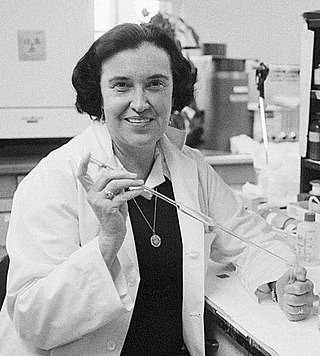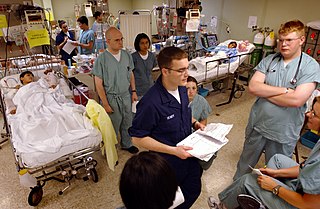Related Research Articles
Medical physics deals with the application of the concepts and methods of physics to the prevention, diagnosis and treatment of human diseases with a specific goal of improving human health and well-being. Since 2008, medical physics has been included as a health profession according to International Standard Classification of Occupation of the International Labour Organization.
The Science Council is a UK organisation that was established by Royal Charter in 2003. The principal activity of The Science Council is the promotion of the advancement and dissemination of knowledge of and education in science pure and applied, for the public benefit. The Science Council is the Competent Authority with respect to the European Union directive 2005/36/EC. It is a membership organisation for learned and professional bodies across science and its applications and works with them to represent this sector to government and others. Together, the member organisations represent over 350,000 scientists. The Science Council provides a forum for discussion and exchange of views and works to foster collaboration between member organisations and the wider science, technology, engineering, mathematics and medical communities to enable inter-disciplinary contributions to science policy and the application of science.

Rosalyn Sussman Yalow was an American medical physicist, and a co-winner of the 1977 Nobel Prize in Physiology or Medicine for development of the radioimmunoassay technique. She was the second woman, and the first American-born woman, to be awarded the Nobel Prize in Physiology or Medicine.
The Royal Australian and New Zealand College of Radiologists (RANZCR) is the leading professional organisation for the promotion of the science and practice of the medical specialties of clinical radiology and radiation oncology in Australia and New Zealand. The college has members throughout the world. RANZCR provides the educational curricula for medical graduates training to enter the specialties.
A medical physicist is a health professional with specialist education and training in the concepts and techniques of applying physics in medicine and competent to practice independently in one or more of the subfields (specialties) of medical physics. A medical physicist plays a fundamental role in applying physics to medicine, but particularly in the diagnosis and treatment of cancer. The scientific and technological progress in medical physics has led to a variety of skills that must be integrated into the role of a medical physicist in order for them to perform their job. The "medical services" provided to patients undergoing diagnostic and therapeutic treatments must, therefore, be the result of different but complementary skills. In general, the medical physicist is responsible for all scientific and technical aspects of imaging, radiation treatment, and radiation safety. It is their occupational role to ensure that medical modalities offered to patients are met with the utmost quality assurance. It is the medical physicist that manage and supervise the efforts of dosimetrists, therapists and technologists in that capacity.

Clinical engineering is a specialty within biomedical engineering responsible for using medical technology to optimize healthcare delivery.

The Institute of Physics and Engineering in Medicine (IPEM) is the United Kingdom's professional body and learned society for physicists, engineers and technologists within the field of medicine, founded in 1995, changing its name from the Institution of Physics and Engineering in Medicine and Biology (IPEMB) in 1997. The Institute is governed by an elected Board of Trustees reporting to which are the Science, Research and Innovation Council and the Professional and Standards Council. The councils have operational responsibility for scientific and professional aspects of the Institute's work, respectively. Beneath the councils is a substructure of committees, groups and panels of members, which undertake the work of the Institute.
Richard Alan Fox was an Australian medical physicist. He was the son of Alan Fox, a businessman, and Rosalind née Morris.
The 1851 Research Fellowship is a scheme conducted by the Royal Commission for the Exhibition of 1851 to annually award a three-year research scholarship to approximately eight "young scientists or engineers of exceptional promise". The fellowship is open to all nationalities and fields of science, including physical or biological sciences, mathematics, applied science, and any branch of engineering. The fellowship can be held anywhere in the United Kingdom.
Leslie Alexander Geddes was an electrical engineer and physiologist. He conducted research in electromyography, cardiac output, cardiac pacing, ventricular defibrillation, and blood pressure. He discovered and demonstrated precisely the optimal sites on the chest for defibrillation or pacing.
The IEEE Marie Sklodowska-Curie Award is a Technical Field Award that was established by the IEEE Board of Directors in 2008. This award may be presented for outstanding contributions to the field of nuclear and plasma sciences and engineering. This award may be presented to an individual, individuals on a team, or up to three multiple recipients. Recipients of this award receive a bronze medal, certificate, and honorarium. This award was presented for the first time in 2011.
The Irish Association of Physicists in Medicine (IAPM) is the Irish learned society for physicists and engineers in medicine. The IAPM was founded in 2010 by the merger of the Association of Physical Scientists in Medicine and the Irish Radiotherapy Physics Group. The aims of the Association are as follows:

Biomedical sciences are a set of sciences applying portions of natural science or formal science, or both, to develop knowledge, interventions, or technology that are of use in healthcare or public health. Such disciplines as medical microbiology, clinical virology, clinical epidemiology, genetic epidemiology, and biomedical engineering are medical sciences. In explaining physiological mechanisms operating in pathological processes, however, pathophysiology can be regarded as basic science.
Xie George Xu was the Edward E. Hood Chair Professor of Engineering at Rensselaer Polytechnic Institute (RPI), Troy, New York, United States, before he relocated in 2020 to China and joined the faculty of the University of Science and Technology of China.

Clive Baldock is a British-born Australian professor. He graduated with a BSc (hons) in Physics from the University of Sussex, an MSc in Radiation Physics from St Bartholomew's Hospital Medical College, University of London, a PhD in Medical Physics from King's College London and a Masters of Tertiary Education Management from the University of Melbourne. He also graduated from the University of Oxford Saïd Business School Executive Leadership Programme. His previous roles included Head of the School of Physics at the University of Sydney, Executive Dean of Science at Macquarie University, Executive Director for Physical Sciences, Engineering, Mathematics and Information Sciences at the Australian Research Council (ARC), Dean of Graduate Research and Pro Vice-Chancellor for Researcher Development at the University of Tasmania, and Dean of Graduate Research at the University of Wollongong.
Physical and Engineering Sciences in Medicine is a quarterly peer-reviewed medical journal covering research in medical physics and biomedical engineering. It is the official journal of the Australasian College of Physical Scientists and Engineers in Medicine and is recognized as an official journal of the International Organization for Medical Physics, Asia-Oceania Federation of Organizations for Medical Physics and the Biomedical College of Engineers Australia.

Roderic Ivan Pettigrew is an American physicist, engineer, and physician who is CEO of EnHealth and Executive Dean for EnMed at Texas A&M University. From 2002-November 2017, he was the founding director of the National Institute of Biomedical Imaging and Bioengineering (NIBIB) at the National Institutes of Health (NIH). He is a pioneer and world expert in cardiovascular magnetic resonance imaging (MRI).
Kimberlee Jane Kearfott is a professor in the Department of Nuclear Engineering and Radiological Sciences at University of Michigan in Ann Arbor, Michigan. The American Nuclear Society recognised her notable contributions to the field of radiation protection in 2017.
The European Federation of Organisations for Medical Physics (EFOMP) was founded in May 1980 in London to serve as an umbrella organisation representing the national Medical Physics societies in Europe. The office moved to Utrecht in January 2021. It is a non-profit organisation and aims to foster and coordinate the activities of its national member organisations, encourage exchange and dissemination of professional and scientific information, develop guidelines for education, training and accreditation programmes and to make recommendations on the responsibilities, organisational relationships and roles of medical physicists.
Caridad Borrás is a Spanish medical physicist. Her career started in 1964 at the Santa Creu i Sant Pau Hospital in Barcelona. From 1988 to 2000, she was Regional Advisor of the Radiological Health Program and, from 2000 to 2002, Coordinator of Essential Drugs and Technology at the Pan American Health Organization in Washington D.C.
References
- ↑ "About ACPSEM - ACPSEM". www.acpsem.org.au. Archived from the original on 16 March 2015.
- ↑ Kron, Tomas; Metcalfe, Peter; Baldock, Clive (2020). "Should ACPSEM develop its own position papers or just adopt those of the AAPM?". Physical and Engineering Sciences in Medicine. 43 (3): 749–753. doi:10.1007/s13246-020-00900-4. PMC 7373210 . PMID 32696436.
- ↑ "Physical and Engineering Sciences in Medicine".